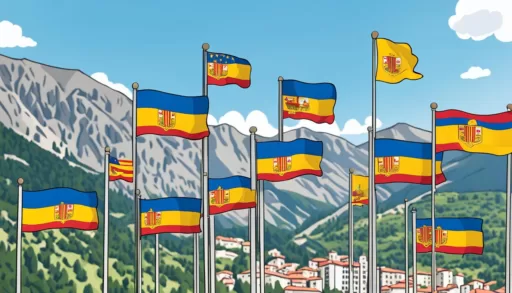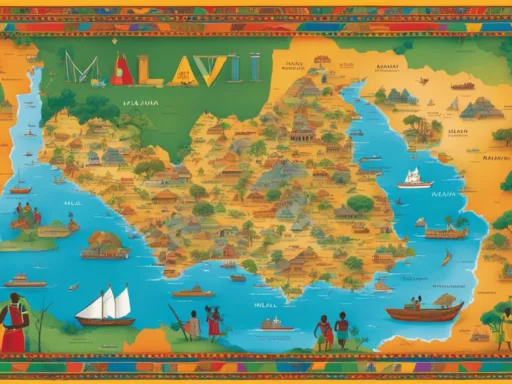Within the heart of the Pyrenees, the languages spoken in Andorra resonate with a melodic blend of multicultural heritage. This small yet vibrant country proudly upholds Catalan as its official language, a linguistic badge of honor that encapsulates its national identity. However, the scenes on the streets of Andorra reveal a rich tapestry of multilingual interactions, with the echoes of Spanish, French, and Portuguese contributing to the everyday life. The dynamic interplay of Andorra languages embodies a truly multilingual Andorra, creating a welcoming atmosphere for both residents and global visitors.
Recent trends have shown an intriguing shift in linguistic preferences. The dappled light of Spanish has gradually given way to the rising sun of Catalan, now the most common mother tongue for over half of the Andorran population. Yet, in this polyglot paradise, the ability to converse in multiple languages is more the rule than the exception. Andorra’s commitment to language reflects its cultural inclusivity, ensuring that anyone stepping into this picturesque nation can find common ground and shared words.
Key Takeaways
- Catalan reigns as the official and increasingly prevalent mother tongue in Andorra, enriching its national essence.
- The languages spoken in Andorra paint a diverse yet harmonious linguistic landscape, with Spanish, French, and Portuguese widely used.
- Andorra’s residents are typically bilingual or multilingual, showcasing the country’s adaptability and cultural richness.
- Language trends display a marked increase in the use of Catalan at home, highlighting a revival and reinforcement of the official language.
- The multilingual Andorra pragmatically embraces its linguistic diversity, balancing cultural heritage with the practicalities of modern communication.
- Understanding the Andorra languages foster seamless interactions, a trait crucial to the nation’s thriving tourism industry.
The Linguistic Tapestry of Andorra
The linguistic landscape of Andorra is as varied and vibrant as a patchwork quilt, with threads of many languages intricately woven together to form its fabric. At the center, Catalan stands out as the historic and official language, a symbol of national pride and unity within this diverse population. Yet, what truly characterizes this small mountainous nation is the effortless multilingualism of its people. Spanish, French, and Portuguese add vibrant splashes of color to this tapestry, owing to Andorra’s close ties with neighboring countries and diverse immigrant communities that enrich the principality’s cultural life.
In examining the progression of languages used at home and outside, we notice how deeply embedded language diversity in Andorra is within the society. While Catalan usage increases, especially in personal spaces, the communicative power of Spanish and French permeates daily interactions in public life. Portuguese, although less prevalent, still plays a significant role due to the sizeable community it represents. This testament to cultural richness is ever-present in the fluent switching between languages that Andorrans are known for, making it a paradise for linguists and casual language enthusiasts alike.

Statistics from various studies highlight these shifts and continuities in preferences and proficiencies. The following table presents the latest trends in language use both at home and outside, reflecting the fluid and evolving linguistic landscape of Andorra:
| Language | At Home | Outside Home | 2018 | 2022 |
|---|---|---|---|---|
| Catalan | 44% | 63.7% | 35.7% | 55.2% |
| Spanish | 40.3% | 48.6% | 43.2% | 37.1% |
| Portuguese | 13.5% | 6.6% | 17.1% | 3.8% |
| French | 10% | 5.7% | 8.9% | 2.2% |
| Others | 9.8% | 4.9% | 6.8% | 1.5%-10% |
As documented in the table, Catalan’s dominance is on the rise, establishing itself more firmly in both domestic and public realms. Nevertheless, the presence of Spanish remains steady and influential, acting as a bridge for communication amongst Andorrans of different linguistic backgrounds. French and Portuguese, while not as predominant, also contribute to the chorus of voices that make Andorra’s societal fabric both dynamic and inclusive.
The multilingual populace of Andorra attests to the nation’s history as a crossroads of cultures and languages. By nurturing this multiplicity of tongues, Andorra celebrates its unique position in the world as a meeting place for various linguistic traditions. It stands as a model of how language can unite diverse peoples, embracing its role as a guardian of heritage and a proponent of multilingual dialogue.
Languages Spoken in Andorra: Beyond the Official Catalan
Peering beyond the emblematic status of Catalan as the official language of Andorra, the principality’s linguistic milieu is further enriched by the widespread fluency in Spanish and French. Due to both historical affinity and contemporary immigration patterns, these languages have a robust presence within Andorran society. Understanding the spoken languages in Andorra is essential to appreciating the diverse communications threads woven throughout this small, yet vibrantly multilingual country.
The Widespread Use of Spanish and French
In the echoing valleys and bustling markets of Andorra, Spanish asserts itself as a critical part of the linguistic ecosystem. A significant portion of the population, particularly immigrants from various regions of Spain, consider Spanish their mother tongue. This kind of integration underlines the complexities within the Andorran language profile and its reflection on sociocultural interactions. Not far behind in its prevalence is French, which rides on the coattails of geographical proximity to Andorra’s French border, further influenced by a steady stream of French nationals whose lives and languages are interlaced with the Andorrans’.

Portuguese: A Significant Minority Language
Portuguese also punctuates the Andorran language landscape, echoing through its streets and alleys thanks to the noteworthy Portuguese community residing within the principality. This segment of the population contributes to a smaller, yet robust representation in the diversity of spoken languages in Andorra. Their cultural and linguistic influence represents an additional thread in the nation’s rich tapestry, showcasing the genuine inclusivity within the Andorran society.
As the bastion of the official languages of Andorra, Catalan is undoubtedly at the helm. Still, it is the felicitous blend with Spanish, French, and Portuguese that illustrates the true linguistic essence of this unique country. The polyglot nature of Andorra is a testament not only to its historical bonds with its neighbors but also to its current cosmopolitan spirit, nurturing a society open to global narratives while cherishing its own.
Andorra’s Multilingual Society and Cultural Influences
Embarking on a journey through Andorra unveils a society where the confluence of European heritage and modern-day immigration has cultivated a multilingual landscape. Multilingual Andorra is not just a term but a living symphony spoken in valleys and on highland trails. The country’s linguistic diversity is both a beacon of its cultural richness and a linchpin of its national identity. Central to this linguistic mosaic is Catalan, a language steeped in the history and sentiment of Andorrans.

Catalan: The Pillar of Andorran Identity
Catalan, the sole official language of the principality, is the cornerstone of Andorran nationality, spoken by a significant portion of the populace. It is more than a means of communication—it is the essence of the principality’s national identity and a reflection of its autonomous spirit. The language policy Andorra has adopted recognizes the cultural significance of maintaining Catalan at the forefront of its national discourse, shaping the country’s character and preserving its cultural heritage.
The Influence of Neighboring Countries on Andorra’s Language Practices
As each bordering country situates its footprints upon the linguistic soil of Andorra, the array of Andorra languages expands. Spanish, the mother tongue of many migrants from the Iberian Peninsula, is the second most commonly spoken language here, serving as a lingua franca amid Andorra’s assorted populace. Further flavoring the cultural melting pot, French and Portuguese have carved out their niches within Andorra’s diverse communities—each language adding dimension and contributing to the country’s global connectivity. It is this seamless linguistic intermingling that underscores the exceptionally multilingual Andorra, balancing tradition and plurality with elegance.
Language Policy Andorra: Promoting the Official Language
In the picturesque realm of Andorra, the language policy Andorra champions Catalan as the mainstay of cultural and communicative endeavors. This strategic promotion is deeply rooted in the nation’s constitution, echoing a commitment to nurture and sustain the official languages Andorra has embraced through time. As a guardian of linguistic richness, the government’s steadfast approach ensures that the essence of Catalan permeates every facet of Andorran life, from the welcoming signposts that greet travelers to the whispering winds that carry its traditions across the Pyrenean highlands.

With an air of inclusiveness, Andorra’s language initiatives actively seek to integrate its immigrant workforce into the societal fabric. These efforts reflect a broader expectation: that all residents, irrespective of origin, attain a commendable proficiency in Catalan. This linguistic integration, juxtaposed against the backdrop of a bustling tourism industry teeming with Spanish dialogue, underlines the principality’s determination to maintain its linguistic sovereignty. It is here that signage – a silent yet persuasive educator – veers towards the national language, setting Catalan as the omnipresent guide in public and private domains alike.
- Public signage in Catalan signifying adherence to the language policy Andorra has set forth.
- Immigrant inclusion programs fostering knowledge of the official languages Andorra holds dear.
- A persistent focus on Catalan Sign Language, intertwining accessibility with cultural celebration.
Sign language, particularly Catalan Sign Language, receives overdue acknowledgment through these initiatives, bridging the gap between the hearing and the non-hearing communities. It is within these silent gestures that the voices of an entire segment find resonance, anchoring Catalan’s inclusivity beyond mere spoken words.
The harmonious blend of language policy in Andorra, with its rich array of official and community languages, weaves a vibrant linguistic tapestry. And as its threads intertwine, residents and visitors alike are enwrapped in the warm embrace of Andorran identity and legacy.
Andorran Language in Education and Media
The Principality of Andorra, nestled in the Pyrenees, is noteworthy for its commitment to preserving and promoting its cultural and linguistic heritage through language education Andorra-centric policies and media representations. The official language, Catalan, is more than just a means of communication; it is an identity marker and a subject of great emphasis in Andorran education and media sectors.

The Role of Catalan in Andorran Schools
Within the Andorran education system, Catalan resonates as the primary medium of instruction, reflecting a deep-rooted education policy Andorra has implemented to bolster language competency among its youth. For learners at all stages, from early childhood to secondary level, Catalan forms the core of the academic experience. This language policy enriches the students’ educational journey, providing pathways to become bilingual or even trilingual, as Spanish and French are also integrated into the curriculum. Hence, the fabric of Andorran schools is interwoven with the richness of multiple languages.
Catalan Dominance in Broadcast and Print Media
In the realm of Andorran media, Catalan takes center stage, uniting the country’s traditional ethos with contemporary culture. Television broadcasts, radio communications, and print publications predominantly utilize Catalan, fostering a sense of commonality and shared cultural narrative. This deliberate language choice underscores the principality’s effort to maintain and disseminate its cherished language across different platforms, significantly shaping public discourse and nation-wide communication.
Understanding the Andorran Language Landscape for Travelers
Visiting the principality of Andorra is a delight for the senses, and for travelers seeking to immerse themselves in local culture, communication plays a key role. One of the facets that make Andorra tourism so unique is the rich multilingual culture Andorra is known for. Here travelers are greeted by a symphony of languages, making the exchange of pleasantries and information a truly international experience.
Language for Communication in Andorran Tourism
Whether exploring the snow-capped ski resorts or the quaint village markets, tourists will find that communication in Andorra is facilitated by the country’s linguistic dexterity. While Catalan is the official language, a remnant of Andorra’s historic roots and present in government and official uses, the tourism sector is adept in catering to an international audience. This means Spanish, French, and Portuguese are widely spoken, especially in tourist hotspots. Visitors can comfortably navigate conversations and transactions in these languages, thanks to the country’s emphasis on promoting linguistic accessibility for its economic mainstay—tourism.
Navigating Andorra’s Multilingual Signage
For travelers, the ease of getting around is crucial, and in Andorra, this is made simpler through multilingual signage. Reflective of Andorra’s multilingual culture, signs and directions often feature multiple languages. This practical and welcoming feature speaks volumes of Andorra’s inclusive sensibility and enhances the travel experience by offering a sense of familiarity amid the splendid Pyrenean landscapes. In border areas like Pas de la Casa, signage in French is particularly noticeable, catering to the influx of tourists and cross-border traffic from France.
As such, the language landscape in Andorra underscores its cosmopolitan ethos and aligns perfectly with the needs of a global traveler. From Catalan to French, the principality embraces its visitors with open arms and open dialogue, exemplifying the interconnected world we live in today.
Conclusion
The vibrant and inclusive character of Andorra is poignantly reflected in its capacity to embrace and foster a tapestry of tongues. The languages spoken in Andorra — Catalan, Spanish, French, and Portuguese — are not mere tools of communication but are interwoven threads that both respect the past and weave the present into a cohesive, culturally rich society. A stroll through the streets of Andorra La Vella or the alpine hills reveals the everyday embodiment of a multilingual Andorra, effortlessly oscillating between languages with a grace that goes beyond geographical borders.
Catalan’s centrality as the official language of Andorra underscores a deep national pride, anchoring the principality’s identity and governing essence. Nevertheless, the pragmatic embrace of Spanish, French, and Portuguese illustrates an Andorra that is open, dynamic, and cosmopolitan. Thus, the linguistic diversity in Andorra is not merely a facet of life but stands as a testament to a society’s ability to blend tradition with modernity, local distinctness with global interconnectedness.
The principality’s approach to harmonizing language in education and emphasizing Catalan in the media, while simultaneously catering to a multilingual tourism industry, showcases a balance that few can claim. In essence, Andorra serves as a uniquely European microcosm of linguistic harmony. Its multilingual tapestry tells a story of a country that is intimately connected to its neighbors, yet confidently distinct in its cultural expression — a European enclave that epitomizes the beauty of linguistic diversity. Andorra, thus, remains an exemplary haven for linguists, travelers, and global citizens alike.
FAQ
What languages are spoken in Andorra?
Andorra’s official language is Catalan. However, due to immigration and proximity to neighboring countries, other commonly spoken languages include Spanish, French, and Portuguese. Language diversity is a hallmark of Andorra, making it a multilingual society.
How does the linguistic landscape of Andorra reflect its diversity?
The linguistic landscape of Andorra shows a vibrant tapestry of languages and cultures. Catalan is central, but the presence of Spanish, French, and Portuguese reveals a society enriched by its historical ties with surrounding nations and the influence of a diverse population.
Are there languages other than Catalan commonly used in Andorra?
Yes, aside from Catalan being the official language, Spanish and French are widely used due to strong historical and immigration links. Portuguese is also significant among the minority communities.
How does the multilingual nature of Andorran society influence its culture?
The multilingual nature of Andorra contributes to its unique cultural identity, fostering connections to the broader European community. Catalan acts as the pillar of Andorran identity, while other languages manifest the influence of neighboring countries.
What is the language policy in Andorra?
Andorra’s language policy focuses on promoting Catalan as the national language. It encourages residents, particularly immigrants, to learn and use Catalan to integrate into society, reflecting the policy’s alignment with Andorra’s constitution.
How is Catalan incorporated in Andorran education and media?
Catalan is the primary language of instruction in Andorra’s educational system, and students are often taught to be bilingual or trilingual including Spanish and French. Catalan is also the dominant language used in broadcast and print media, which helps perpetuate the language and culture.
What should travelers to Andorra know about the language situation?
Travelers should be aware that Andorra is a multilingual country with Catalan as the official language. However, in tourist areas and especially near borders, Spanish, French, and Portuguese are also spoken, facilitating communication. Multilingual signage is common, helping visitors navigate and enjoy their stay.
Can visitors get by with only speaking English in Andorra?
While Catalan, Spanish, French and Portuguese are the main languages spoken in Andorra, English is also spoken, especially in the tourism sector. Visitors can usually communicate in English in most hotels, restaurants, and ski resorts.
Is Catalan Sign Language recognized in Andorra?
Catalan Sign Language is recognized and used by the deaf community in Andorra as part of the country’s commitment to language diversity and inclusivity. It is one of the various forms of communication supported by community services.






